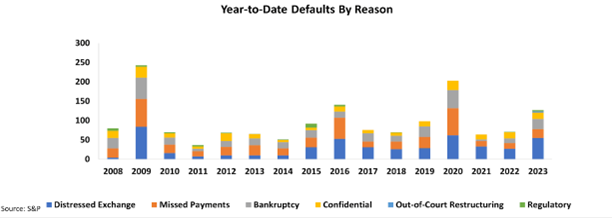We have to measure more than bankruptcies

Bankruptcies aren’t the only data that matter when measuring economic health.
They’re certainly a factor, and they’re not looking good today. U.S. bankruptcies are on track for their worst year since the Great Recession.
However, when companies are under stress, they have more options than simply declaring bankruptcy.
You see, bankruptcy is just about the worst-case scenario for a company.
Companies will try their best to restructure without entering bankruptcy, or they might get as close to default as possible without ever entering default. Chinese developer Country Garden came within days of default twice this year but managed to make payments both times.
If you’re only paying attention to bankruptcies, you’re missing the bigger picture. Today, we’ll take a look at other overlooked categories that can help us understand how healthy corporate America is.
Investor Essentials Daily:
The Monday Macro Report
Powered by Valens Research
Bankruptcies aren’t even the biggest form of default this year.
That title goes to the “distressed exchange.”
A distressed exchange happens when a company is struggling with its debt and wants to avoid bankruptcy. The company has the option to try negotiating with its lenders.
They might offer to buy back the debt at a steep discount, or they might renegotiate buying back the current debt in exchange for a much smaller debt. The key point is it’s not like normal refinancing – the lender is taking a discount.
For instance, the company may offer to buy back its bonds at a lower price, like 15 cents for each dollar of the bond’s value. This move helps the company avoid bankruptcy and lets creditors get back some of their money.
Take Swedish real estate company SBB, for example. Earlier this year, SBB tried buying back some of its bonds for an 85% discount, until credit rating agency S&P Global (SPGI) warned it would be labeled as a “selective default.”
When we zoom out our view of corporate health beyond bankruptcies, we can see just how many companies are struggling.
This year, more companies have undergone more distressed exchanges rather than having gone bankrupt. More companies still have missed interest payments, entered out-of-court restructuring, and confidential restructuring procedures that don’t show up in the bankruptcy numbers.
Since 2008, only three years have looked worse… 2009, 2016, and 2020.
2009 was the bulk of the Great Recession. In 2016, thousands of oil and gas companies struggled after energy prices tanked. And 2020’s economy was hit by COVID-19.
Take a look…

Corporate stress is building… and more companies than you might realize are on the brink of bankruptcy.
With signs of stress now matching the tough times of 2020, the outlook is grim.
Bankruptcies are rising and overall corporate stress is pointing to a recession on the horizon. With distressed exchanges also on the rise, things may only get worse.
Bankruptcy data is important. However, it’s better for seeing how bad the economy is… rather than how bad it might get.
Clearly, more companies are right on the edge of bankruptcy than most people realize. That’s a good reminder of just how much worse the outlook could get in the coming months.
Best regards,
Joel Litman & Rob Spivey
Chief Investment Strategist &
Director of Research
at Valens Research




